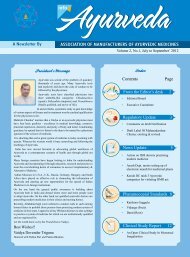Volume 2, No.5, July to September' 2013 - amam-ayurveda.org
Volume 2, No.5, July to September' 2013 - amam-ayurveda.org
Volume 2, No.5, July to September' 2013 - amam-ayurveda.org
Create successful ePaper yourself
Turn your PDF publications into a flip-book with our unique Google optimized e-Paper software.
Pharmacopoeial Standards for Ayurvedic Formulations<br />
and Raw Materials<br />
DEFINITION<br />
ASVAGANDHADYARISTA<br />
(API, PART – II, VOL –II)<br />
Asvagandhadyarista is fermented liquid preparation made with the<br />
ingredients in the Formulation composition given below. It contains not<br />
more than 10 per cent, and not less than 5 per cent of alcohol that is self<br />
generated in the preparation over a period of time.<br />
FORMULATION COMPOSITION<br />
1 Asvagandha API Withania somnifera Rt. 2.4 kg<br />
2 Musali API Chlorophytum tuberosum Rt. 960 g<br />
3 Manjistha API Rubia cordifolia Rt. 480 g<br />
4 Haritaki API Terminalia chebula P. 480 g<br />
5 Haridra API Curcuma longa Rz. 480 g<br />
6 Daruharidra API Berberis aristata St. 480 g<br />
7 Madhuka (Yasti API) Glycyrrhiza glabra Rt. 480 g<br />
8 Rasna API Pluchea lanceolata Rt./Lf.* 480 g<br />
9 Vidari API Pueraria tuberosa Rt. Tr. 480 g<br />
10 Partha (Arjuna API) Terminalia arjuna St. Bk. 480 g<br />
11 Mustaka (Musta API) Cyperus rotundus Rz. 480 g<br />
12 Trivrt (API) Ipomoea turpethum Rt. 480 g<br />
13 Ananta (Sveta sariva API) Hemidesmus indicus Rt. 384 g<br />
14 Syama (Krsna sariva API) Cryp<strong>to</strong>lepis buchanani Rt. 384 g<br />
15 Sveta candana API Santalum album Ht. Wd. 384 g<br />
16 Rakta candana API Pterocarpus santalinus Ht. Wd. 384 g<br />
17 Vaca API Acorus calamus Rz. 384 g<br />
18 Citraka API Plumbago zeylanica Rt. 384 g<br />
19<br />
Jala API for decotion<br />
reduced <strong>to</strong><br />
Praksepa dravyas<br />
Water<br />
info Ayurveda, <strong>Volume</strong> 2, <strong>No.5</strong>, <strong>July</strong> - Sept’ <strong>2013</strong><br />
98.304 l<br />
12.2881<br />
20 Maksika (Madhu API) Honey 14.4<br />
21 Dhataki API Woodfordia fruticosa Fl. 768 g<br />
22 Sunthi API Zingiber officinale Rz. 96 g<br />
23 Marica API Piper nigrum Fr. 96 g<br />
24 Pippali API Piper longum Fr. 96 g<br />
25 Tvak API Cinnamomum zeylanicum St. Bk. 192 g<br />
26 Ela (Suksmaila API) Elettaria cardamomum Sd. 192 g<br />
27 Patra (Tejapatra API) Cinnamomum tamala Lf. 192 g<br />
28 Priyangu API Callicarpa macrophylla Fl. 192 g<br />
29 Nagakesara API Mesua ferrea Stmn. 96 g<br />
*Actual part used in the formulation<br />
METHOD OF PREPARATION<br />
Take the raw materials of pharmacopoeial quality.<br />
Wash, dry and powder the ingredients numbered 1 <strong>to</strong> 18 (Kvatha dravya)<br />
of the formulation composition individually and pass through the sieve<br />
number 44 <strong>to</strong> obtain coarse powder.<br />
Clean, dry and powder the ingredients numbered 22 <strong>to</strong> 29 (Praksepa<br />
dravya) of the formulation composition individually and pass through the<br />
sieve number 85 <strong>to</strong> obtain fine powder.<br />
Add specified amounts of water <strong>to</strong> the Kvatha dravya, soak overnight,<br />
heat, reduce <strong>to</strong> one eighth and filter through muslin cloth <strong>to</strong> obtain Kvatha.<br />
Allow <strong>to</strong> cool.<br />
Transfer the filtrate <strong>to</strong> clean container; add ingredient numbered 20, 21, of<br />
the formulation composition. Finally add the finely powdered Praksepa<br />
dravyas and seal the mouth of the container.<br />
Shift the container <strong>to</strong> the fermentation room and constantly check for the<br />
signs of completion of fermentation process.<br />
Filter the fermented material through a clean muslin cloth.<br />
Pack in air tight containers and allow for maturation.<br />
DESCRIPTION<br />
Clear, dark brown liquid without frothing and significant sedimentation;<br />
with astringent taste<br />
IDENTIFICATION<br />
Thin Layer Chroma<strong>to</strong>graphy:<br />
Dry 50 ml of the formulation in vacuum <strong>to</strong> remove the self generated<br />
alcohol. Add 50 ml water <strong>to</strong> dissolve the extract and partition successively<br />
with n-hexane (50 ml x3) and chloroform (50 ml x 3). Filter and concentrate<br />
the chloroform extract under vacuum and weigh. Dissolve 20 mg of<br />
residue in ml of chloroform and carry out the thin layer chroma<strong>to</strong>graphy.<br />
Apply separately 10 µl of solution prepared as above an 5 µl of standard<br />
solution of withanolide D prepared by dissolving 1 mg in 1 ml of methanol,<br />
on TLC plate and develop the plate <strong>to</strong> a distance of 8 cm using <strong>to</strong>luene:<br />
ethyle acetate: acetic acid (5:4:1) as mobile phase. After development,<br />
allow the plate <strong>to</strong> dry in air and spray with anisaldehyde-sulphuric acid<br />
reagent followed by heating at 105º for about 10 minutes and examine<br />
under ultraviolet light (366 nm). It shows major spots at R f 0.27 (dark<br />
purple), 0.44 (purple, corresponding <strong>to</strong> withanolide D), 0.61 (light grey),<br />
and 0.70 (dark brown).<br />
PHYSICO-CHEMICAL PARAMETERS<br />
Total phenolic content:<br />
Total solids:<br />
Specific gravity (at 2500): 1.05 <strong>to</strong> 1.20<br />
pH: 3.50 <strong>to</strong> 4.50<br />
Reducing sugars:<br />
Non-reducing sugars:<br />
Alcohol content:<br />
Methanol:<br />
0.104 <strong>to</strong> 0.260 per cent w/v equivalent <strong>to</strong><br />
tannic acid<br />
Not less than 18.5 per cent w/v<br />
Not less than 13 per cent w/v<br />
Not more than 0.70 per cent w/v<br />
5 <strong>to</strong> 10 per cent v/v<br />
Absent<br />
Other requirements: Microbial limit: & Afla<strong>to</strong>xins:<br />
(As per Appendix mention in API)<br />
6




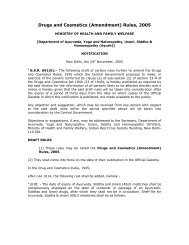
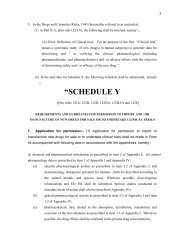
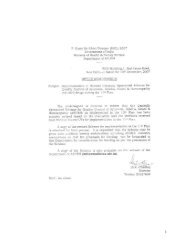

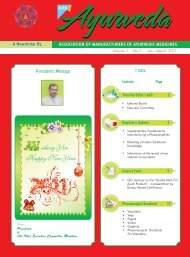

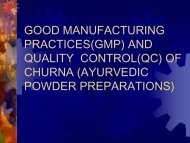
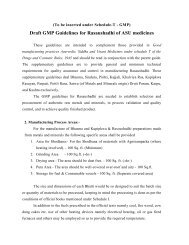
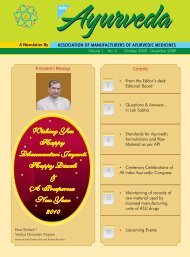
![[To be published in Gazette of India Part II Section 3, sub-section iii]](https://img.yumpu.com/28570283/1/190x245/to-be-published-in-gazette-of-india-part-ii-section-3-sub-section-iii.jpg?quality=85)

